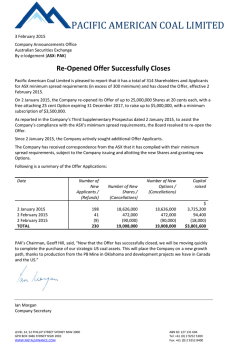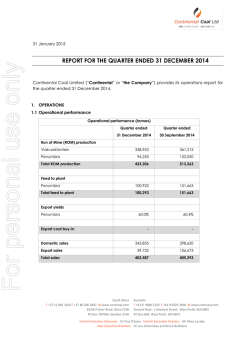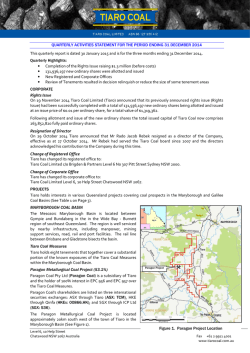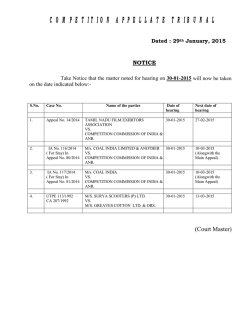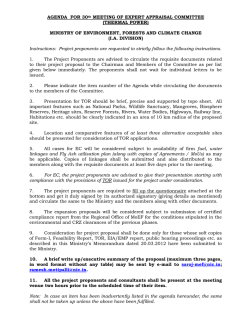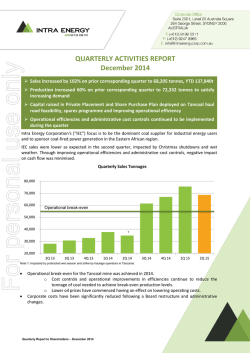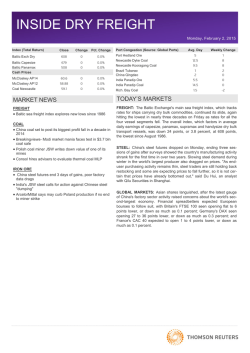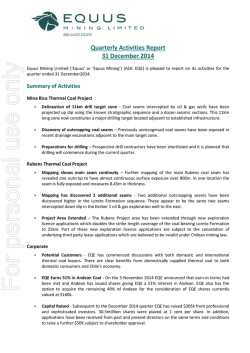
South Africa Overview - Marcon International, Inc.
‹ Countries South Africa Last Updated: April 29, 2015 (Notes) full report Overview South Africa has a large energyintensive coal mining industry. The country has limited proved reserves of oil and natural gas and uses its large coal deposits to meet most of its energy needs, particularly in the electricity sector. South Africa also has a sophisticated synthetic fuels industry, producing gasoline and diesel fuels from the Secunda coaltoliquids (CTL) and Mossel Bay gastoliquids (GTL) plants. South Africa's energy sector is critical to its economy, as the country relies heavily on its largescale, energyintensive coal mining industry. South Africa has limited proved reserves of oil and natural gas and uses its large coal deposits to meet most of its energy needs, particularly in the electricity sector. Most of the oil consumed in the country, used mainly in the transportation sector, is imported from Middle East and West African producers in the Organization of the Petroleum Exporting Countries (OPEC) and is locally refined. South Africa also has a sophisticated synthetic fuels industry, producing gasoline and diesel fuels from the Secunda coaltoliquids (CTL) plant and Mossel Bay gastoliquids (GTL) plant. The synthetic fuels industry accounts for nearly all of the country's domestically produced petroleum as crude oil production is very small. South Africa's economy has grown rapidly since the end of the apartheid era in 1994, and the country is now one of the most developed nations in Africa. South Africa has the second largest economy in Africa, in terms of gross domestic product (GDP), and has the highest energy consumption on the continent, accounting for about 30% of total primary energy consumption in Africa, according to BP Statistical Review of World Energy 2014.1 Despite rapid economic growth over the past decades, economic problems from the apartheid era remain, particularly poverty and the lack of economic participation among disadvantaged groups. The South African government has committed to ensuring that blackowned companies have access to the energy sector under its Black Economic Empowerment (BEE) program. Additionally, the 2000 Petroleum and Liquid Fuels Charter sets a target to place 25% of the oil industry (across all facets) in the hands of blackcontrolled energy companies. According to a recent study by the U.S. Energy Information Administration (EIA), South Africa holds notable shale gas resources. The South African government hopes that shale gas will provide the country with a reliable alternative fuel to coal. However, regulatory uncertainty and environmental concerns continue to delay exploration. Some progress was recently made on the issue when the Petroleum Agency South Africa (PASA) announced in October 2014 that it would start processing existing applications for exploration permits. In 2013, 72% of South Africa's total primary energy consumption came from coal, followed by oil (22%), natural gas (3%), nuclear (3%), and renewables (less than 1%, primarily from hydropower), according to BP Statistical Review of World Energy 2014 (Figure 1).2 South Africa's dependence on coal has led the country to become the leading carbon dioxide emitter in Africa (accounting for 40% of emissions in Africa) and the 13th largest emitter in the world, according to the latest (2012) EIA estimates. Source: U.S. Department of State Energy sector management PetroSA, a South African stateowned company, operates upstream oil and natural gas producing assets in South Africa, along with the GTL plant in Mossel Bay. Sasol, a privatelyowned company based in South Africa, operates the Secunda CTL plant, has a majority interest in the Natref oil refinery, partially owns the pipeline transporting natural gas from Mozambique to South Africa, and is involved in coal mining. Regulatory organizations South Africa has several government agencies and companies involved in the coal, natural gas, and oil sectors. The Petroleum Agency of South Africa (PASA) regulates oil and natural gas exploration and production and provides public data on exploration and production. The National Energy Regulator of South Africa (NERSA) regulates the electricity sector, natural pipeline industries, and petroleum pipeline industries. NERSA regulates electricity prices and promotes private sector participation by encouraging investment by independent power producers (IPPs), and offgrid technologies to meet rural energy needs. Eskom–the wholly stateowned electricity company–generates roughly 95% of South Africa's electricity and owns and operates the national electricity grid.3 Major companies South Africa's upstream oil and natural gas sectors are dominated by the stateowned company Petroleum Oil and Gas Corporation of South Africa (PetroSA), while the downstream oil sector is more diversified and includes companies from Europe, North America, and Asia. BP, Shell, Chevron, Total, and Engen are the main players in the downstream oil and petrochemical industry. PetroSA operates all upstream oil and natural gas producing assets in South Africa, along with the GTL plant at Mossel Bay. The company also participates in oil and gas activities internationally. Sasolis another major player in South Africa's energy industry and operates Secunda, one of the world's largest coalbased synthetic fuels plant. The company holds majority interest in the 88,000 barrels per day (bbl/d) Natref refinery. Sasol is also involved in coal mining and marketing of natural gas and oil products. According to Sasol's factsheet, the company mines 40 million tons (MMt) of saleable coal per year (mostly used at the Secunda CTL plant) and sells about 2.8 MMt per year. Sasol distributes and markets natural gas produced in Mozambique, which is exported to South Africa via a pipeline partially owned by Sasol.4 Sasol has operations around the world, ranging from supplying petrochemicals to using its proprietary FischerTropsch conversion technology to pursue opportunities to open GTL plants. Sasol has a 49% stake in Qatar's Oryx GTL plant (Qatar Petroleum owns 51%) that came online in 2007. Sasol also has GTL projects in Nigeria and Uzbekistan. Sasol is also considering developing a GTL plant at Lake Charles, Louisiana in the United States and a GTL plant in Alberta, Canada.5 Major companies that participate is South Africa's coal sector include Anglo American, BHP Billton, and Xstrata Coal. The South Africanbased, majority blackowned, coal company Exxaro also ranks among the top producers. Coal mining in South Africa is mainly undertaken by privatelyowned companies, and the shareholders of Richards Bay, the main coal port, are all private companies as well. The stateowned company Transnet controls the railways used to transport coal from the mines to the ports. Coal South Africa has the world's ninthlargest amount of recoverable coal reserves and holds 95% of Africa's total coal reserves. Environmental groups continue to target the industry for air, land, and water pollution. However, coal consumption in South Africa is expected to continue to increase as new coalfired power stations are scheduled to come online to meet rising demand for electricity. According to the BP Statistical Review of World Energy 2014, South African proved coal reserves were estimated at 33 billion short tons at the end of 2013 (Figure 2), accounting for 95% of total African coal reserves and 3% of total world reserves. South Africa's economy is heavily dependent on coal, as it accounts for about 72% of the country's total primary energy consumption (Figure 1). The electricity sector accounts for more than half of the coal consumed in South Africa, followed by Sasol's petrochemical industries, metallurgical industries, and domestic heating and cooking, according to an Eskom November 2014 factsheet.6 South Africa's coal production and consumption levels remained relatively stable over the past decade. In 2013, the country produced an estimated 286 million short tons (MMst) and consumed 202 MMst of coal (Figure 3). Most of the coal produced comes from the Witbank, Highveld, and Ermelo coal fields, which are located in the eastern part of the country near Swaziland. South Africa has the potential to increase coal production, particularly from the resourcerich Waterberg basin. But increasing production depends on the country's ability to expand its railway and export capacity. One of the main bottlenecks to increasing coal exports is the lack of railway infrastructure used to transport coal from the mines to the ports. Transnet, South Africa's railway operator, plans to invest billions of dollars to expand railway infrastructure. However, South Africa's major export projects are experiencing delays.7 According to the International Energy Agency (IEA), although South Africa has a number of mining projects underway, it is unclear how much future coal production will be allocated to domestic electricity generation versus coal exports. South Africa's electricity consumption is increasing and coal production will be needed to fuel new power plants that are currently under construction. Environmental groups continue to target the coal industry for air, land, and water pollution through all of the industry's stages from extraction to end use. Nonetheless, coal use— especially by Eskom and Sasol—is expected to rise over the next few years. Eskom plans to expand coalfired electricity capacity to meet growing demand by bringing online the coal fired Medupi power station (4,764 MW) and the coalfired Kusile plant (4,800 MW) in stages over the next few years. Coaltoliquids (CTL) South Africa produces synthetic fuels from lowgrade coal and a small amount from natural gas. At the Sasol synfuels plant in Secunda, more than 37 MMst of coal each year are converted into liquid fuels and a range of chemical feedstock. The plant houses two factories with a total capacity of 160,000 bbl/d of oil equivalent. Sasol plans to expand Secunda's capacity by another 30,000 bbl/d and has proposed to build the 80,000bbl/d Mafutha CTL plant.8 Any future increases in CTL synthetic fuels will be used to meet growing domestic demand for petroleum products. Exports South Africa exports more than 25% of its coal production. Most of South Africa's coal exports are sent to Asia, with India being the largest recipient. South Africa exported 78 million metric tons (or 86 million short tons) of coal in 2014. Asia received more than half of South Africa's coal exports, with the largest destination being India, which accounted for 40% of South Africa's coal exports (Figure 4). Europe is the secondlargest regional importer of South Africa's coal, followed by Africa, the Middle East, and the Americas. More than 90% of South Africa's coal is exported via the Richards Bay Coal Terminal (RBCT), and the remainder is exported via the Maputo and Durban terminals.9 RBCT is located on the eastern coast of South Africa and is one of the world's largest coal export terminals. It began operation with a nameplate capacity of 12 million metric tons (MMt) per year in 1976, and it has since gone through several capacity expansions, increasing the export terminal's nameplate capacity to its current level of 91 MMt per year. There are proposals to expand RBCT's capacity to 110 MMt per year, but these plans are constrained by inadequate rail capacity needed to transport coal produced at inland coal fields to the RBCT. Although the terminal chronically operates below capacity, there has been progress over the past few years to increase the terminal's throughput volumes. In 2013, the RBCT exported more than 70 MMt (77.4 MMst) of coal for the first time, and exports increased again to 71.3 MMt (78.6 MMst) in 2014 (Table 1). Table 1. Richards Bay coal terminal shipping statistics million metric tons Year Coal shipped 2011 2012 2013 2014 65.5 68.3 70.2 71.3 Source: Richards Bay Coal Terminal, Reuters Natural gas South Africa imports natural gas from Mozambique via pipeline to supply Sasol's Secunda CTL plant and to fuel some gasfired power plants. South Africa produces a small volume of natural gas offshore, and it is mainly used to supply the Mossel Bay GTL plant. In 2013, South Africa produced 41 billion cubic feet (Bcf) of dry natural gas and consumed 173 Bcf; the difference of 132 Bcf was imported from Mozambique via pipeline (Figure 5). South Africa has very limited proved natural gas reserves, but potentially large shale gas resources. Most of South Africa's natural gas is produced from the maturing offshore FA field and South Coast Complex fields and sent to the GTL facility in Mossel Bay via an offshore pipeline. PetroSA is developing the FO field, also known as Project Ikhwezi, to sustain gas supplies to the GTL facility in the future. The company expects gas production to last for six years at the FO field, but it plans to tap into nearby prospective areas to continue gas flows to the GTL plant. PetroSA is also planning to develop the Ibhubesi gas field and expects first production in 2016. The government hopes that new gas production from the FO and Ibhubesi fields and regional imports from Mozambique, coupled with potential gas imports from Namibia in the future, will reduce the country's reliance on coal in the electricity and industrial sector. Currently, infrastructure constraints limit the role of natural gas in the country's electricity sector. PetroSA is considering building a floating regasification facility to supply the GTL plant in the future.10 Shale gas resources EIA estimates that South Africa holds 390 trillion cubic feet (Tcf) of technically recoverable shale gas resources. Environmental concerns led the government to place a moratorium on shale gas exploration from April 2011 to September 2012. In October 2013, the government released proposed new regulations to govern the exploration of shale resources. International companies are still waiting to be issued permit licenses for shale exploration. According to a June 2013 report released by EIA, South Africa has 390 Tcf of technically recoverable shale gas resources, making the country the eighthlargest holder of technically recoverable shale gas resources in the world. Technically recoverable resources represent the volumes of oil and natural gas that could be produced with current technology, regardless of oil and natural gas prices and production costs, according to the report. South Africa's shale gas resources are located in the Karoo basin in the Whitehill (211 Tcf), Prince Albert (96 Tcf), and Collingham (82 Tcf) formations. EIA lowered its estimate from 485 Tcf to 390 Tcf in the most recent report because the prospective area for the three shale formations in the Karoo basin was reduced by 15%. The Whitehill Shale's recovery rate and resource estimate were also reduced because of the geologic complexity, according to the report. Environmental concerns regarding water usage and hydraulic fracturing (fracking), one of the processes used to facilitate the extraction of shale gas, led the government to enact a moratorium in April 2011 on issuing exploration licenses for shale gas exploration. The moratorium was lifted in September 2012 after a governmentfunded study recommended that it was safe to continue shale gas exploration. In October 2013, South Africa's cabinet proposed new technical regulations to govern petroleum exploration, particularly standards for shale gas exploration and hydraulic fracturing. The Petroleum Agency South Africa (PASA) announced in October 2014 that it would start to process existing applications for permits to explore the Karoo basin, although PASA will not process new applications. Gastoliquids (GTL) The GTL plant at Mossel Bay was commissioned in 1992 and is one of the largest in the world. PetroSA operates the plant, in addition to the offshore gas fields that provide the fuel. The plant has the capacity to process 45,000 bbl/d of liquid fuels through a FischerTropsch Process in which natural gas is converted to synthetic liquid fuels. The plant produces several synthetic liquid fuels, of which more than half is unleaded petrol (motor gasoline) and the remainder includes: kerosene (paraffin), diesel, propane, liquid oxygen and nitrogen, distillates, ecofuels, process oils, and alcohols.11 Natural gas pipelines Natural gas from Mozambique is imported through the 535mile Sasol Petroleum International Gas pipeline and transported to Sasol's Secunda synfuels plant. Sasol, the South African government, and the government of Mozambique own the pipeline through a joint venture. The pipeline has a peak capacity of 524 million cubic feet per day of natural gas and was part of a $1.2billion natural gas project started in 2004.12 It is designed eventually to be able to transport double its current capacity. The governments of South Africa and Mozambique, along with SacOil Holdings, a South Africabased oil and gas company, are studying the possibility of constructing a $6 billion natural gas pipeline, running from Mozambique's northeastern province Cabo Delgado to South Africa.13 There have been several significant gas discoveries in Mozambique's northeastern Rovuma Basin over the past few years. South Africa is a viable market for Mozambique's future production given South Africa's limited proved gas reserves and its need to sustain production at its GTL plant. Petroleum and other liquids South Africa has small amounts of proved crude oil reserves, and the country's crude oil production is very small. Synthetic fuels, derived from coal and natural gas, account for more than 90% of the country's domestic petroleum production. According to the Oil & Gas Journal, South Africa has proved crude oil reserves of 15 million barrels.14 All of the proved reserves are located offshore southern South Africa in the Bredasdorp Basin and off the west coast of the country near the maritime border with Namibia. South Africa's petroleum and other liquids (total oil) production was about 160,000 bbl/d in 2014 (Figure 6). Synthetic fuels, derived from coal and natural gas, accounted for more than 90% of the country's domestic petroleum supply. Less than 5,000 bb/d of crude oil and lease condensate is produced at the Oribi and Oryz fields operated by PetroSA. The country's crude oil and lease condensate production continues to decline as oil fields mature and as commercially viable discoveries are not made. South Africa's offshore Orange Basin near Namibia is believed to hold substantial oil and gas resources, although there has been limited exploration activity in the area. In 2009, Shell acquired exploration rights over a large block in the basin. However, Shell's exploration activities are still in the early stages, and the company is years away from potentially exploiting any commercial reserves. Downstream South Africa consumes the secondlargest amount of petroleum in Africa, behind Egypt. The petroleum consumed in South Africa comes mostly from its domestic refineries that import crude oil and its CTL and GTL plants. South Africa imports crude oil mostly from OPEC countries in the Middle East and West Africa. EIA estimates that South Africa's total oil consumption was 655,000 bbl/d in 2014. The petroleum consumed in South Africa comes mostly from its domestic refineries that import crude oil and its CTL and GTL plants. The country also imports petroleum products. In 2014, South Africa imported 120,000 bbl/d of petroleum products mostly from Asia, according to the South African Revenue Service as published by Global Trade Information Services (GTIS).15 Refining South Africa has the secondlargest crude oil distillation capacity in Africa at 503,000 bbl/d, surpassed only by Egypt, according to the OGJ January 2015 estimates (Table 2).16 The government has proposed plans to implement new, tighter fuel standards that would require upgrades at all refineries. However, because of low returns on investment, refinery operators are hesitant to upgrade their facilities. Furthermore, tariffs on refined product pipelines recently increased. The government needed the additional funds to finance the construction costs for a new multifuel pipeline between Durban and Johannesburg, which will replace the existing aging infrastructure and increase pipeline capacity. The new fuel standards, coupled with the increase in pipeline tariffs, will raise refiners' operational costs. The government's initial deadline to upgrade the refineries was 2017, but this target has been delayed to 2020 or beyond.17 PetroSA has been advocating for the construction of a new 300,000 bbl/d refinery at Coega near Port Elizabeth, known as Project Mthombo (also known as the Coega plant). If the refinery is built, the refinery would be designed to meet the new fuel standards. The refinery is intended to meet a potential shortfall in locally refined diesel and gasoline by 2020. PetroSA and Sinopec are jointly funding a study for the construction of the refinery, but no official decision to undertake the venture has been made, and progress has been limited.18 Crude oil imports In 2014, South Africa imported 425,000 bbl/d of crude oil, according to South African Revenue Service, as published by GTIS. South Africa imports crude oil mostly from OPEC countries, namely Saudi Arabia (38%), Nigeria (31%), and Angola (12%) (Figure 7). South Africa's top oil supplier has shifted from Iran to Saudi Arabia in recent years. In 2011, Iran was South Africa's largest crude oil supplier, accounting for about 27% of South Africa's total crude oil imports.19 But in 2012, South Africa's crude imports from Iran dropped because of U.S. and European Union (EU) sanctions against Iran. U.S. sanctions, directed toward foreign financial institutions that facilitate oilrelated transactions with the Central Bank of Iran, entered into full force in July 2012. To avoid the sanctions, Iranian crude importers had to show or pledge significant reductions in their Iranian crude oil purchases to receive a 180day renewable exemption. South Africa halted Iranian crude oil imports before the July 2012 deadline and was granted exemptions. South Africa has not resumed imports from Iran, and the country continues to substitute Iranian imports with supplies from Saudi Arabia, Nigeria, Angola, and other countries. Table 2. South African crude oil refinery capacity Refinery Company Sapref Enref Chevref Natref Total Shell and BP PLC Petroleum Engen Petroleum Caltex Oil SA (Chevron) National Petroleum Refiners Location Durban Capacity (bbl/d) 170,000 Durban 135,000 Cape 110,000 Town Sasolburg 88,000 Source: Oil & Gas Journal, January 2015 503,000 Electricity South Africa's electricity system is constrained because the margin between peak demand and available electricity supply is very small. In November 2013, Eskom requested that its largest industrial customers cut their electricity consumption by 10% during peak demand times. South Africa's nominal (nameplate) installed electricity capacity is about 45,645 megawatts (MW), although total net maximum capacity (nominal capacity minus the amount the power station uses to operate) is lower. Eskom supplies roughly 95% of South Africa's electricity, and the remainder comes from independent power producers (IPPs) and imports. Eskom buys and sells electricity with countries in the region. South Africa is a member of the Southern African Power Pool (SAPP), which began in 1996 as the first formal international power pool in Africa with a mission to provide reliable and economical electricity supply to consumers in SAPP member countries. Eskom exports electricity to Lesotho, Namibia, Botswana, Zimbabwe, Mozambique, Swaziland, and Zambia, and it imports electricity from electricity from Namibia, Lesotho, and Mozambique.20 South Africa plans to diversify its electricity generation mix. Currently, more than 85% of South Africa's installed electricity capacity is coalfired power stations, 10% hydroelectric plants, 4% a nuclear power plant, and 1% nonhydro renewable energy (Table 3). South Africa's renewable energy industry is small, but the country plans to expand renewable electricity capacity through its Renewable Independent Power Producer (IPP) Procurement Program. IPP projects have been expanding, and last year 21 IPP renewable energy projects were connected to the grid, amounting to 1,076 MW of new installed capacity.21 South Africa's electricity system is constrained as the margin between peak demand and available electricity supply has been precariously narrow since 2008. In 2008, some coal mines had to halt operations because of power blackouts. In November 2013, Eskom requested that its largest industrial customers cut their consumption by 10% during peak demand times to avoid unexpected blackouts or loadshedding (scheduled power cuts). South Africa's power problems escalated in late 2014 when the coal storage silo collapsed at one of the largest coal power plants, Majuba (4,110 MW installed capacity). The problem was addressed, and power was soon restored. However, the incident highlights problems with South Africa's fragile electricity infrastructure, as the vast majority of coal power plants are outdated, poorly maintained, and pushed to their maximum working capacity. Inadequate investment during periods of increased economic growth, rising electricity demand, and mismanagement of the sector have been attributed to the power failures. Eskom plans to bring online almost 12,000 MW of new electricity installed capacity (Table 3). However, cost overruns, construction delays, and labor strikes have caused project delays, exacerbating South Africa's power problems.22 Table 3. South Africa's power stations and nominal installed capacity 1 (unit: megawatts) Coalfired plants Arnot Camden Duvha Grootvelei Hendrina Kendal Komati Kriel Lethabo Majuba Matimba Matla Tutuka *Medupi *Kusile Natural gas turbine stations Acacia Port Rex Ankerlig Gourikwa 2,352 1.510 3,600 1,200 1,965 4,116 940 3,000 3,708 4,110 3,990 3,600 3,654 4,764 4,800 171 171 1,338 746 Hydroelectricity Conventional hydro stations Gariep 360 Vanderkloof 240 Pumped storage schemes Drakensberg 1,000 Palmiet 400 *Ingula 1,332 Other hydropower stations (operated by Distribuion Division) Colley Wobbles 42 Second Falls 11 First Falls 6 Ncora 2 Other renewable energy stations Klipheuwel (wind) 3 *Sere Wind Facility 100 *Concentrating Solar Power 100 (CSP) Nuclear Koeberg 1,910 Independent Power Producers (IPPs)2 Total nominal installed capacity (existing) *Eskom new builds (planned capacity additions) 1,500 45,645 11,096 1The table provides nominal (nameplate) capacity, which is higher than the country's actual total net maximum capacity. 2Capacity among IPPowned power stations represents total installed capacity owned by independent companies. All other power plants in the table are owned by Eskom, South Africa's stateowned utility company. Source: Eskom Fact Sheet, May 2014 Notes Data presented in the text are the most recent available as of April 29, 2015. Data are EIA estimates unless otherwise noted. Endnotes 1 BP, Statistical Review of World Energy, Excel workbook of historical data, 2014. 2 BP, Statistical Review of World Energy, Excel workbook of historical data, 2014. 3 Statistics South Africa, Electricity produced and consumed in South Africa, 2014. 4 Sasol official website, Sasol Facts, 20122013. 5 Sasol official website, GasToLiquids Facility. 6 Eskom, Generation Communication, Fact Sheet: Coal in South Africa, (November 2014). 7 International Energy Agency, MediumTerm Coal Market Report 2013, page 1145 and MediumTerm Coal Market Report 2014, page 103. 8 Sasol official website, Sasol Facts, 20122013. 9 International Energy Agency, MediumTerm Coal Market Report 2014, page 103. 10 PetroSA, Annual Report, 2014. 11 PetroSA, Annual Report, 2014. 12 United Nations, Africa Renewal Online, "Pipeline benefits Mozambique, South Africa," (October 2007). 13 Bloomberg Business, "South Africa, Mozambique, Study $6 Billion Gas Pipeline," (December 8, 2014). 14 Oil & Gas Journal, Worldwide look at reserves and production, (January 1, 2015). 15 Global Trade Information Services, South African Revenue Service, accessed April 1, 2015. 16 Oil & Gas Journal, Worldwide refining capacity, (January 1, 2015). 17 Mail and Guardian, "Journey towards cleaner fuel stalls," (May 16, 2014) and Business Day Live, "Refineries R40bn upgrade faces delays," (April 2, 2014). 18 Business Day Live, "No movement on Coega refinery a year later," (July 24, 2014). 19 Global Trade Information Services, South African Revenue Service, accessed April 1, 2015. 20 Eskom, Integrated Report 2014, page 32. 21 Eskom, Integrated Report 2014, page 22. 22 Global Risk Insights, "South Africa's power crisis inhibits growth," (December 22, 2014) and Times Live, "Majuba power station increases capacity: Eskom," (November 6, 2014). Figure and table sources Figure 1. Total primary energy consumption in South Africa and Figure 2. Top 10 coal reserve holders, end of 2013: BP, Statistical Review of World Energy, Excel workbook of historical data, 2014. Figure 4. South Africa's coal exports, by destination, 2014 and Figure 7. South Africa's crude oil imports, by country of origin, 2014: Global Trade Information Services, South African Revenue Service, accessed April 1, 2015. Table 1. Richards Bay Coal Terminal Shipping Statistics. Coal shipped in 201113: Richards Bay Coal Terminal, Shipping Statistics, accessed January 2014. Coal shipped in 2014: Reuters Africa, "S. Africa's Richards Bay Coal Terminal exports record level in 2014," (January 20, 2015). Table 2. South African Crude Oil Refinery Capacity: Oil & Gas Journal, Worldwide refining capacity, (January 1, 2015). Table 3. South Africa's power stations and nominal installed capacity: Eskom, Generation Communication, Fact Sheet: Coal in South Africa, (November 2014).
© Copyright 2025
